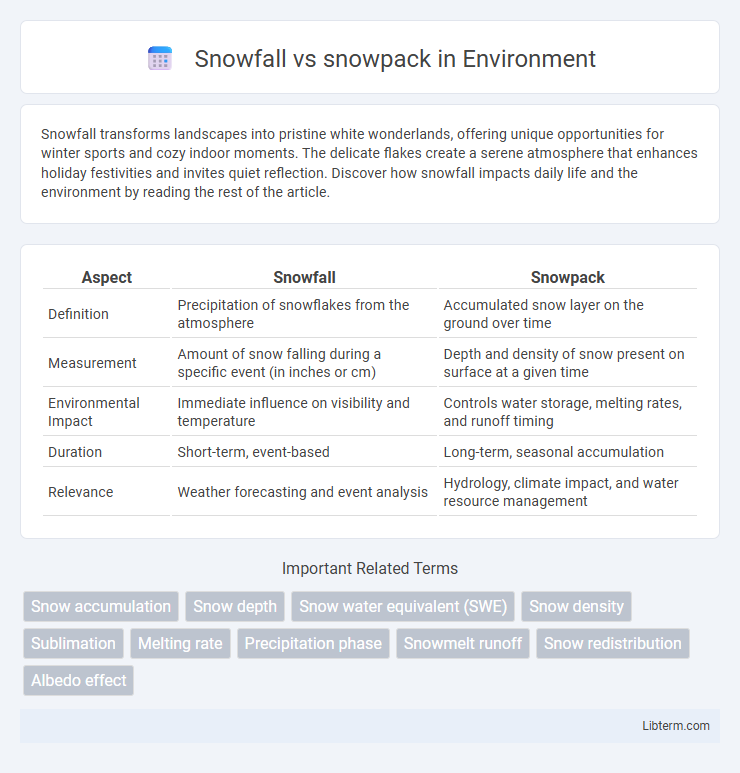Snowfall transforms landscapes into pristine white wonderlands, offering unique opportunities for winter sports and cozy indoor moments. The delicate flakes create a serene atmosphere that enhances holiday festivities and invites quiet reflection. Discover how snowfall impacts daily life and the environment by reading the rest of the article.
Table of Comparison
| Aspect | Snowfall | Snowpack |
|---|---|---|
| Definition | Precipitation of snowflakes from the atmosphere | Accumulated snow layer on the ground over time |
| Measurement | Amount of snow falling during a specific event (in inches or cm) | Depth and density of snow present on surface at a given time |
| Environmental Impact | Immediate influence on visibility and temperature | Controls water storage, melting rates, and runoff timing |
| Duration | Short-term, event-based | Long-term, seasonal accumulation |
| Relevance | Weather forecasting and event analysis | Hydrology, climate impact, and water resource management |
Introduction to Snowfall and Snowpack
Snowfall refers to the total amount of snow that falls to the ground over a specific period, typically measured in inches or centimeters. Snowpack, on the other hand, represents the accumulated layer of snow that remains on the ground, which can vary in depth and density based on temperature and environmental conditions. Understanding the distinction between snowfall and snowpack is crucial for assessing water resources, avalanche risk, and climate monitoring.
Defining Snowfall: Characteristics and Measurement
Snowfall refers to the amount of snow that falls to the ground during a specific weather event, measured using standard tools such as snow gauges or rulers in inches or centimeters. It captures the fresh accumulation of snowflakes, highlighting factors like intensity, duration, and spatial distribution of precipitation. Accurate snowfall measurement is critical for meteorological analysis, flood forecasting, and assessing water resource inputs in snow-dominated regions.
Understanding Snowpack: Formation and Structure
Snowpack forms as accumulated snowfall compresses and undergoes metamorphosis, creating distinct layers of snow with varying density, temperature, and moisture content. This stratification influences stability, where weaker layers can lead to avalanches, and monitoring snowpack structure is essential for water resource management and winter sports safety. Understanding the physical properties of snowpack, including grain size and bonding, helps predict its behavior throughout the season.
Key Differences Between Snowfall and Snowpack
Snowfall refers to the amount of snow that falls during a specific weather event, measured in inches or centimeters, while snowpack represents the accumulation of snow on the ground over time. Snowpack density and depth vary depending on temperature, compaction, and melting processes, making it a critical factor for water resource management and avalanche risk assessment. Understanding the difference between snowfall and snowpack helps in predicting snowmelt runoff and seasonal hydrology forecasting.
Factors Influencing Snowfall Patterns
Snowfall patterns are influenced by factors such as temperature fluctuations, humidity levels, and geographic features like elevation and nearby water bodies that affect moisture availability. Snowpack accumulation depends on the intensity and duration of snowfall events, as well as post-depositional processes including temperature variations, wind redistribution, and melt-freeze cycles. Understanding these elements is crucial for accurate hydrological forecasting and assessing water resource availability in snow-dependent regions.
Processes Affecting Snowpack Accumulation
Snowfall contributes directly to snowpack accumulation by depositing new snow layers on the ground, influenced by weather patterns and temperature fluctuations. Snowpack accumulation is further affected by processes such as sublimation, melting, and compaction, which alter the snow's density and water content over time. Variations in solar radiation, wind redistribution, and underlying terrain also impact snowpack stability and longevity, critical factors for hydrological models and water resource management.
Climate Impact on Snowfall and Snowpack
Climate change significantly affects snowfall patterns and snowpack stability, altering water availability and ecosystem dynamics. Rising temperatures lead to reduced snowfall and faster snowpack melt, disrupting seasonal water storage critical for agriculture and hydropower. Changes in snowfall intensity and snowpack depth also increase the risk of floods and diminish the resilience of mountain habitats.
Snowfall and Snowpack in Water Resource Management
Snowfall refers to the precipitation of snowflakes that directly contributes to the accumulation of snow on the ground, serving as a primary input in water resource systems. Snowpack denotes the consolidated layer of snow that has accumulated over a season, acting as a natural reservoir that gradually releases water during melt periods, vital for maintaining streamflow and groundwater recharge. Effective water resource management relies on accurate measurement and prediction of snowfall and snowpack to optimize water supply forecasting, flood control, and ecosystem sustainability.
Snowpack and Avalanche Risk
Snowpack refers to the accumulated layers of snow on the ground, whose stability directly impacts avalanche risk. Variations in snowpack density, temperature gradients, and layering create weak points that can trigger avalanches under stress. Monitoring snowpack characteristics through snow pits and stability tests is essential for accurate avalanche forecasting and risk mitigation.
Conclusion: Importance of Distinguishing Snowfall from Snowpack
Distinguishing snowfall from snowpack is vital for accurate hydrological forecasting and water resource management, as snowfall refers to the amount of snow that falls during a storm, while snowpack denotes the cumulative snow accumulated on the ground over time. Snowpack assessments provide critical data for predicting spring runoff, reservoir refill, and potential flood risks, which snowfall measurements alone cannot offer. Understanding the differences between these two metrics enables more precise climate modeling and supports sustainable environmental planning in snow-dependent regions.
Snowfall Infographic

 libterm.com
libterm.com